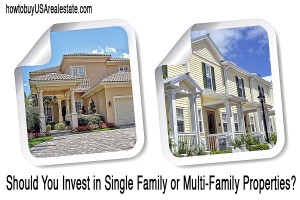Should You Invest in Single Family or Multi-Family Properties?
So which is better, a single family investment or a multi-family investment? This interesting debate has always interested me. I see some people get very defensive when debating this question as they state their case for whatever happens to be their preferred investment.
 Clearly these debates suggest one clear objective. The answer lies within your passion. What is it you want to accomplish and what level of management do you wish to undertake? While a property management commonly may be hired to run the properties in either case, there are still a number of considerations to take into account for either investment.
Clearly these debates suggest one clear objective. The answer lies within your passion. What is it you want to accomplish and what level of management do you wish to undertake? While a property management commonly may be hired to run the properties in either case, there are still a number of considerations to take into account for either investment.
Clearly there is no right and no wrong answer here. The best investment for you is one that best fulfills your objective and investment strategies. We will look at the pros and cons of each but first things first.
Where do you buy these investments?
Before trying to identify the best product for you, (Single family or multifamily). You want to establish the first objective for any and all investors, where should you invest. If you have any interest in real estate investing you will understand the expression, “real estate is all about Location, Location, Location.” You always want to invest in the best location. Safety and sustainable investments is the goal so identifying where to invest should be the first objective, Single family or Multi- family, lets break it down with the top 3 Pros and cons for each.
Single family pros:
1. Fewer turnovers; tenants tend to call a single family (their home) they tend to own more things and as they are happy in their home with more belongings they tend to live there longer. This equates to less tenant turnover and less expenses for the owner.
2. More controlled expenses: On a single family rental the tenants typically pay for all utility expenses. The only expense paid by the owner are the standard taxes and insurance (perhaps a mortgage) this provides for more predictability over the cash flow.
3. Higher equity growth: Appreciation is one of the best wealth building principles and is best captured in the single family market. The best equity growth position will of course be the property that will sell to a retail buyer at the time you sell. Retail buyers are buyers who want to buy for themselves and / or perhaps a family . The single family home has always been the most highly sought after property for a homebuyer and therefore will demand the best (retail) pricing. Obviously buying the right property in the best market for equity growth position is paramount to capitalize on this equity growth.
Single Family Cons:
1. One tenant: (on lease) when the property is vacant there is no revenue coming in. Another reason location is so important. Always want to own rental in a highly sought after location where housing is in highest demand.
2. Price per unit: the cost per unit (commonly referred to as per door cost) is higher than the per door cost of a multifamily property. This higher (per door cost) often reduces the cash flow on a per door basis.
3. Higher repair costs: with one unit there is no economy of scale pricing so repairs can be more expensive.
Multi-family pros:
1. Economy of scale pricing: with multiple units you can often get better pricing.
2. Financing: Loans for Multifamily properties are tied to the financial merits and performance
3. Higher cash on cash returns: when seeking higher cash on cash returns for the Multi- family. You have one roof that needs repair and multiple tenants to help pay for repairs. Or you have multiple units to manage so a property manager may discount the fees/ of the building (for units 5 and more). delivers (again tied to economy of scale)
Multi-family Cons:
1. More transient tenants: one of the largest expenses to the owner is the turnover cost of tenants. Apartment dwellers tend to be smaller families or individuals who move more often. Resulting in higher cost and less predictable returns.
2. More tenant issues: the more people living under one roof the more domestic challenges you encounter.
3. Additional maintenance cost. All common areas such as hallways maintenance, paint, electricity and cleaning as well as lawn care and snow removal (where applicable) are the owners cost. These costs reduce the controls the owner has over expenses.
As you can see there are pros and cons to both investments. Deciding what is most important to you will help you narrow down the best investment for you.
Who tends to buy the single family investments: the investor looking for a nice passive investment where they can hire a property manager and not have to worry about a variety of issues arising. These investors simply want a nice safe and sustainable investment secured by real estate. They have a larger desire for a nice mix of cash flow and equity growth.
Who tend to invest in multifamily investments: this investor tends to be more actively involved in the investment. Even with a property manager they understand they will have to be involved with the decision making process to the variety of items that arise from the number of units they own. This investor tends to have a bigger desire for cash flow than for equity build up as the values of the building is only tied to the rents that are generated.
